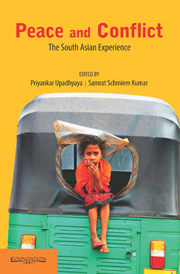9 results
Introduction
-
-
- Book:
- Peace and Conflict
- Published by:
- Foundation Books
- Published online:
- 05 October 2014
- Print publication:
- 28 May 2014, pp xi-xx
-
- Chapter
- Export citation
Contributors
-
- Book:
- Peace and Conflict
- Published by:
- Foundation Books
- Published online:
- 05 October 2014
- Print publication:
- 28 May 2014, pp 237-240
-
- Chapter
- Export citation
Preface
-
- Book:
- Peace and Conflict
- Published by:
- Foundation Books
- Published online:
- 05 October 2014
- Print publication:
- 28 May 2014, pp vii-x
-
- Chapter
- Export citation
Bibliography
-
- Book:
- Peace and Conflict
- Published by:
- Foundation Books
- Published online:
- 05 October 2014
- Print publication:
- 28 May 2014, pp 241-242
-
- Chapter
- Export citation

Peace and Conflict
- The South Asian Experience
-
- Published by:
- Foundation Books
- Published online:
- 05 October 2014
- Print publication:
- 28 May 2014
Index
-
- Book:
- Peace and Conflict
- Published by:
- Foundation Books
- Published online:
- 05 October 2014
- Print publication:
- 28 May 2014, pp 243-250
-
- Chapter
- Export citation
Contents
-
- Book:
- Peace and Conflict
- Published by:
- Foundation Books
- Published online:
- 05 October 2014
- Print publication:
- 28 May 2014, pp iii-iv
-
- Chapter
- Export citation
Frontmatter
-
- Book:
- Peace and Conflict
- Published by:
- Foundation Books
- Published online:
- 05 October 2014
- Print publication:
- 28 May 2014, pp i-ii
-
- Chapter
- Export citation
3 - Peace Pedagogies in South Asia: Interreligious Understanding
-
-
- Book:
- Peace and Conflict
- Published by:
- Foundation Books
- Published online:
- 05 October 2014
- Print publication:
- 28 May 2014, pp 44-62
-
- Chapter
- Export citation



